
Specific grades of Master Bond polymer systems retain high performance properties even upon exposure to multiple sterilization cycles.
Worldwide manufacturers of disposable and reusable medical devices specify Master Bond sterilization resistant adhesives, sealants, coatings, potting and encapsulation compounds for their most demanding needs. They are USP Class VI certified and designed to adhere well to a wide range of substrates. Select products also meet ISO 10993-5 cytotoxicity requirements. These user friendly products can be cured at ambient temperatures, elevated temperatures or by exposure to UV light.
Hydrogen Peroxide Sterilization
Master Bond and STERIS collaborated in research to determine the compatibility of Master Bond’s specialty epoxies with Vaporized Hydrogen Peroxide (VHP™) using V-PRO® s2 Low Temperature Sterilization System.
This study was recently published in a peer-reviewed journal Polymer-Plastics Technology and Materials.
Learn more about this study
Adhesives, Sealants and Coatings with Outstanding Sterilization Resistance
Grades are available that resist the following sterilization methods:
- Steam autoclave
- Ethylene oxide (EtO)
- Radiation
- Chemical sterilants including glutaraldehyde, peracetic acid, Cidex® and Sterrad®.
Select products will retain their performance properties even upon exposure to multiple sterilization cycles. These products are formulated for reusable medical devices. In addition, compounds also provide protection against disinfectants, detergents, isopropyl alcohol and bleaches.
Ethylene Oxide Sterilization Resistant Adhesives Excel in Medical Device Construction
High strength formulations are engineered to ensure that the functionality/performance and safety/reliability of healthcare devices are guaranteed after ETO sterilization processing. Master Bond products consist of biocompatible epoxy, silicone, cyanoacrylate and UV/LED curing adhesives. Suitability of specific grades are dependent on substrate materials, intended device use, configuration and size.
ETO sterilization is commonly utilized in the assembly of disposable medical devices to assure appropriate sterility. Key processing parameters including gas concentration, humidity, temperature, time need to be established to comply with specifications to kill/eliminate microorganisms such as bacteria, viruses, molds, yeast. ETO sterilization main advantage over other sterilization methods is its suitability for use on heat/humidity sensitive devices. Additionally it is also non corrosive to plastics, rubbers, metals, provides wide surface accessibility, will not discolor plastics, and is cost effective.
Master Bond multiple ETO resistant adhesives offer a range of properties. High/low viscosity systems feature toughness, optical clarity, fast cures, thermal conductivity, electrical conductivity, low water absorption and vibration/impact resistance. These products can be automatically dispensed for the high volume assembly of:
- Catheters
- Respirators
- Ophthalmic instruments
- Syringes
- Integrated electronics
- Reservoirs and housings
- Oxygenators
- Tube sets and fittings
Epoxy Adhesives Withstand Exposure to Steam Autoclaving
Steam sterilization resistant biocompatible epoxy adhesive/sealants are used for the assembly of reusable/disposable medical devices. These USP Class VI approved systems will not degrade during steam autoclaving. Select formulations are engineered to retain their strength after multiple autoclave cycles. Common sterilization cycles consist of 3-15 minutes at 121-134°C under steam pressure up to 20 psi. Duration of exposure is dependent on device weight, dimension, design and substrate compatibility with sterilization environment. Epoxy bonded devices can be safely utilized by licensed practitioners for patients without risk of infection from spores, bacteria, fungi, viruses over their intended life after proper sterile processing.
It is important to note that steam sterilization is widely employed because of its ease of use, effectiveness, low capital expense, quick cycle speeds and that it generates little waste. Master Bond steam sterilization resistant adhesive/sealants have been embraced by manufacturers of bronchoscopes, esophagoscopes, endoscopes, colonscopes, arthroscopes and laparoscopic instruments for their performance/reliability. Gap filling compositions feature high mechanical strength properties to similar/dissimilar substrates including metal/metal, metal/plastic, metal/ceramic surfaces. Stress caused by humidity/temperature will not effect structural integrity of the bonded interface. These products are easily automatable.
Learn more about the autoclaving resistance for specific Master Bond medical adhesives.
Most Popular Sterilization Resistant Polymer Systems
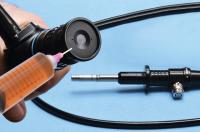 |
EP42HT-2Med Low viscosity, two part epoxy with outstanding chemical resistance. Passes USP Class VI biocompatibility tests. Capable of withstanding repeated sterilization cycles including radiation, EtO, chemical sterilants, autoclaving. Serviceable from -60°F to +450°F. Cures at room or elevated temperatures. Available in amber-clear and black colors. Castable in thicknesses up to 2-3 inches. |
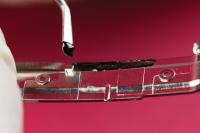 |
EP42HT-4AOMed Black Thermally conductive, electrically insulative two part epoxy. Meets USP Class VI and ISO 10993-5 certifications. Cryogenically serviceable from 4K to +400F. NASA low outgassing aproved. Black in color. For bonding, sealing, coating and casting. |
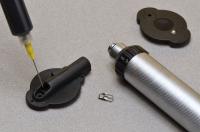 |
UV10TKMed Biocompatible, high viscosity, UV curable compound. Optically clear. Glass transition temperature of more than 140°C. Rapid curing, no mix system. Withstands repeated sterilization. Meets USP Class VI and ISO 10993-5 cytotoxicity testing requirements. Serviceable from -60°F to +450°F. |
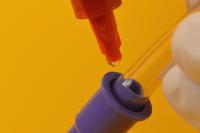 |
UV15DC80Med USP Class VI approved one component UV and heat curable epoxy. Passes ISO 10993-5 cytotoxicity testing. Cures at temperatures as low as 80°C. Moderate viscosity. Minimal shrinkage upon cure. Capable of withstanding liquid sterilants, radiation, autoclaving. Serviceable from -60°F to +400°F. |
 |
EP62-1Med Two part epoxy requiring moderate heat curing (80-120°C). Meets USP Class VI biocompatibility specifications. Superb resistance to repeated autoclaving along with excellent adhesion to high temperature plastics such as Ultem, PEEK, etc. Exceptionally long working life. Outstanding electrical insulation properties. Serviceable from -60°F to +450°F. |
 |
EP62-1HTMed Superior sterilization resistance. Two part epoxy has long pot life at ambient temperatures. High bond strength properties. Ideal for bonding and coating. Good flow. Reliable electrical insulator. Serviceable from -60°F to +450°F. Tg 150-155°C. Shore D hardness 80-90. |
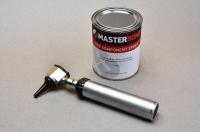 |
EP3HTND-2Med Black Rapid curing, one part epoxy. Meets USP Class VI biocompatibility standards. Non-drip, paste viscosity. High shear strength. Superb resistance to autoclaving, chemical sterilants, radition, EtO. Serviceable from -60°F to +400°F. |
 |
EP62-1LPSPMed White Sterilization resistant, cryogenic ISO 10993-5 epoxy for medical device assembly. White pigment. Low viscosity. |
